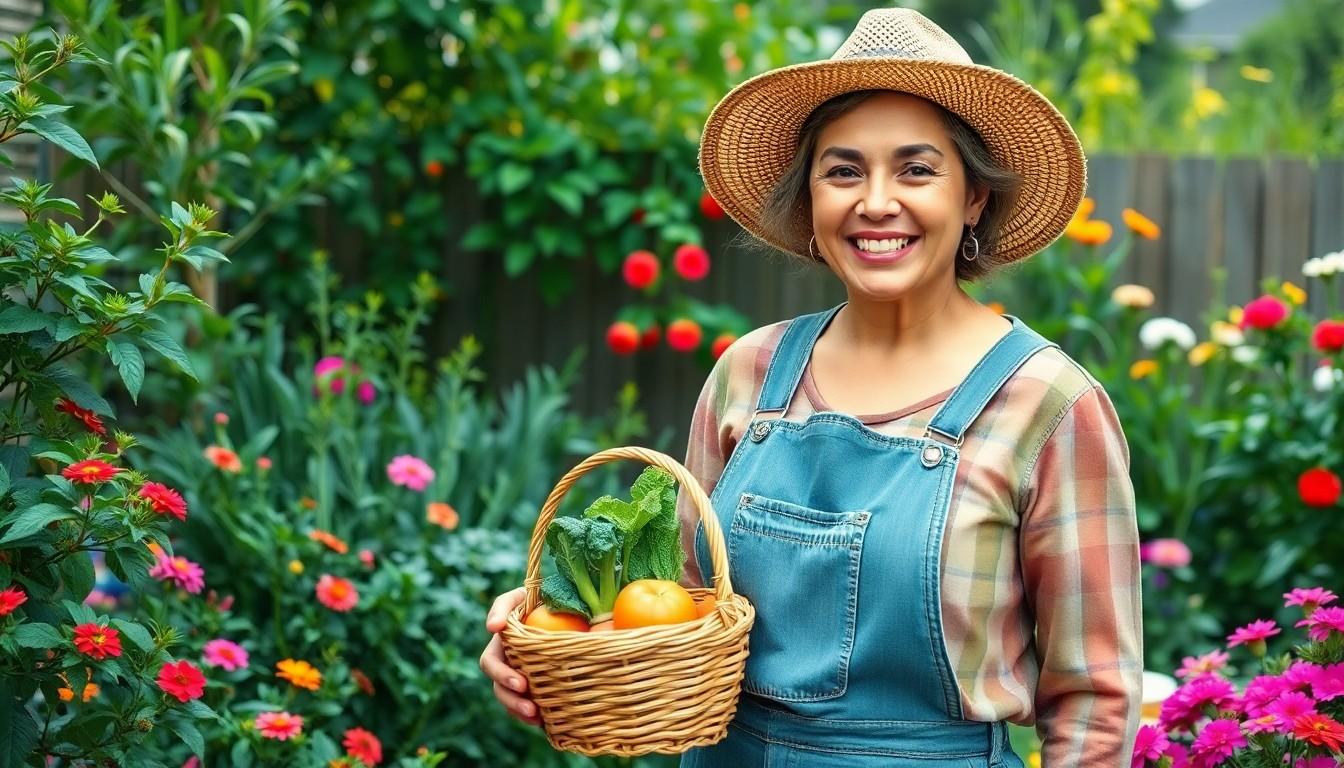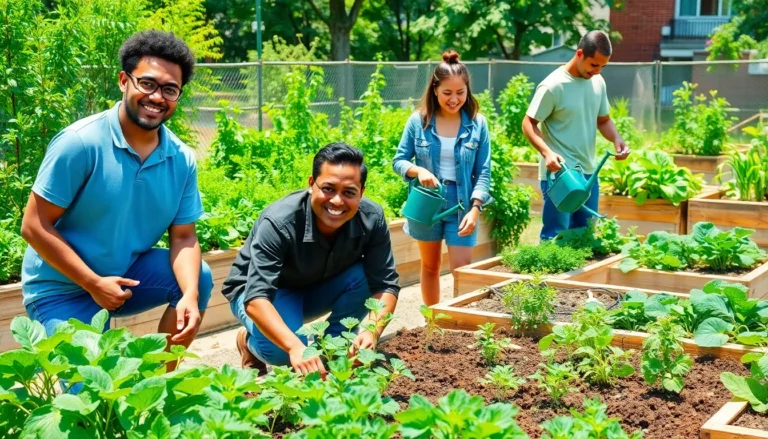In a world where “going green” isn’t just a trend but a necessity, homeowners are finding themselves at the forefront of the sustainability movement. Imagine transforming a cozy home into an eco-friendly haven without sacrificing comfort or style. It’s not just about saving the planet; it’s about saving money too. Who knew being eco-conscious could feel so good?
From swapping out those energy-guzzling appliances to embracing the charm of a vegetable garden, sustainable living offers a wealth of opportunities. These tips will help homeowners make small changes that lead to big impacts. So grab your reusable shopping bags and let’s dive into some practical, and even a little quirky, ways to turn your home into a green sanctuary. After all, saving the Earth can be fun—and who doesn’t love a good pun about composting?
sustainable living tips for homeowners
Sustainable living involves making choices that reduce one’s environmental impact while promoting well-being. Homeowners can maintain comfort and style through eco-friendly practices that safeguard the planet for future generations.
Definition of Sustainable Living
Sustainable living focuses on minimizing resource consumption and waste generation. It emphasizes using renewable materials, conserving energy, and reducing pollution to preserve ecosystems. Simple actions, like choosing local produce or utilizing natural cleaning products, embody this lifestyle. Homeowners embrace sustainability by making conscious decisions that benefit both their households and the environment.
Importance of Sustainable Practices
Sustainable practices yield significant benefits for homeowners and communities. Incorporating these practices fosters substantial energy savings, leading to lower utility bills. Additionally, reducing waste limits landfill contributions, promoting a cleaner planet. Implementing sustainable methods enhances property value and attracts environmentally conscious buyers. Supporting local economies through sustainable choices strengthens communities. Ultimately, sustainable living fosters a healthier, more vibrant environment, benefiting all who inhabit it.
Energy Efficiency in the Home

Energy efficiency directly impacts sustainability for homeowners. Implementing effective strategies can reduce energy consumption and save on utility costs.
Choosing Energy-Efficient Appliances
Selecting energy-efficient appliances plays a crucial role in reducing household energy use. Many appliances now carry the ENERGY STAR label, indicating compliance with strict energy efficiency guidelines. Refrigerators, washing machines, and dishwashers are excellent examples of devices that often consume less energy while providing the same performance quality. Energy-efficient models can cut energy consumption by 10% to 50% compared to standard appliances. Homeowners should assess their current appliances to identify replacement opportunities, leading to long-term savings and a lower environmental footprint.
Implementing Smart Home Technology
Smart home technology offers innovative solutions for energy efficiency. Homeowners can control lighting, heating, and cooling systems remotely, optimizing usage based on occupancy. Smart thermostats, for instance, can adjust temperatures automatically, maintaining comfort while conserving energy. Additionally, smart plugs and lighting systems can schedule device operation to match peak energy times, minimizing waste. By integrating smart devices into their homes, individuals can monitor energy use in real time, making adjustments that further enhance efficiency and support sustainable living practices.
Water Conservation Techniques
Homeowners can adopt effective water conservation techniques to reduce usage and promote sustainability. Implementing these practices helps minimize waste while maintaining a comfortable living environment.
Low-Flow Fixtures and Appliances
Low-flow faucets and showerheads significantly reduce water consumption. These fixtures can decrease water usage by up to 50%, making a notable impact on both utility bills and the environment. Toilets equipped with low-flow designs also contribute to conservation efforts, using much less water per flush compared to standard models. Additionally, homeowners should consider ENERGY STAR-rated appliances, which integrate water-saving features while ensuring efficiency in daily tasks. Switching to these fixtures and appliances ultimately leads to substantial water savings.
Rainwater Harvesting Systems
Rainwater harvesting systems collect and store rainwater for landscape irrigation and non-potable uses. A well-designed system captures rainwater from rooftops and directs it into storage tanks, preventing runoff and promoting groundwater recharge. Homeowners can harvest thousands of gallons each year, significantly reducing dependence on municipal water supplies. Implementing this technique not only conserves water but also decreases water bills and supports local ecosystems. Integrating these systems into landscaping efforts encourages a sustainable use of resources for years to come.
Sustainable Landscaping Ideas
Homeowners can create beautiful, sustainable landscapes by incorporating environmentally friendly practices. Sustainable landscaping not only enhances aesthetics but also promotes biodiversity and conservation efforts.
Native Plant Selection
Choosing native plants offers numerous benefits for sustainable landscaping. Native plants require less water and maintenance compared to non-native species, making them ideal for conservation. They provide habitats for local wildlife, including beneficial insects and birds. Selecting plants that thrive in local conditions encourages biodiversity, resulting in healthier ecosystems. For instance, homeowners in the Midwest can opt for coneflowers and black-eyed Susans, while those in the Southwest might choose desert marigolds or agave. These choices enhance landscape resilience and contribute to water conservation.
Organic Gardening Practices
Adopting organic gardening practices fosters sustainable growth while minimizing environmental impact. Using organic fertilizers and pesticides reduces chemical runoff, enhancing soil health. Crop rotation and companion planting improve soil structure and fertility, promoting a more robust garden. Homeowners can also mulch around plants to retain moisture and suppress weeds, reducing water usage. Techniques like composting create nutrient-rich soil amendments, contributing to healthier gardens. For example, incorporating kitchen scraps and yard waste into compost bins enriches soils organically. By prioritizing organic methods, homeowners create vibrant gardens that support their ecosystems.
Reducing Waste at Home
Creating a waste-efficient home involves practical strategies that minimize environmental impact. Homeowners can easily implement these methods to promote sustainability.
Composting Organic Waste
Composting organic waste reduces landfill contributions significantly. Kitchen scraps like vegetable peels and coffee grounds transform into nutrient-rich soil through this process. Homeowners can set up simple compost bins in backyards or use indoor composting systems. These systems often require little space and are efficient. Additionally, many communities offer composting workshops, making it easier for individuals to start. The end result enriches garden soil, promoting healthy plant growth.
Recycling Programs and Initiatives
Recycling programs play a crucial role in waste reduction. Local municipalities often provide residents with recycling bins for plastics, paper, and metals. Participating in these initiatives helps divert materials from landfills and reduces overall waste. Homeowners can inquire about specific guidelines regarding accepted materials, as they can vary by location. Schools and community centers frequently host recycling drives, encouraging participation in recycling efforts. Engaging in these programs fosters a culture of sustainability and minimizes environmental impact effectively.
Eco-Friendly Home Improvements
Home improvements can significantly enhance sustainability in a home. Choosing sustainable materials for renovations often leads to lower environmental impacts.
Sustainable Materials for Renovations
Opt for reclaimed wood when upgrading flooring or furniture. Bamboo serves as another excellent choice; it grows rapidly and absorbs carbon dioxide efficiently. Recycled steel offers strength and durability, making it ideal for structural supports or roofing. Use low-VOC paints to reduce indoor air pollution while maintaining aesthetic appeal. Additionally, consider non-toxic insulation options that improve energy efficiency without harmful chemicals. Sourcing local materials minimizes carbon footprints while supporting community economies.
Green Building Certifications
Pursuing green building certifications can validate eco-friendly efforts. The LEED certification ranks as one of the most recognizable, promoting energy efficiency and resource conservation. The Green Globe certification recognizes sustainable tourism practices, emphasizing reduced environmental impact. Homeowners can explore the ENERGY STAR program for energy-efficient appliances and homes, translating to significant cost savings. The National Green Building Standard focuses on durability and health while minimizing waste. Engaging in these certifications helps homeowners showcase their commitment to sustainable living while enhancing property value.
support local ecosystems
Embracing sustainable living not only benefits the environment but also enhances the homeowner’s quality of life. By implementing eco-friendly practices and making mindful choices, individuals can create a comfortable and stylish home that aligns with their values.
Every small change contributes to a larger impact, whether it’s installing energy-efficient appliances or starting a vegetable garden. Homeowners have the power to transform their spaces into green sanctuaries that promote well-being and support local ecosystems.
As they embark on this journey, the rewards extend beyond personal satisfaction, fostering a healthier planet for future generations. Sustainable living is not just a responsibility; it’s an opportunity to enjoy a fulfilling lifestyle while making a positive difference.




